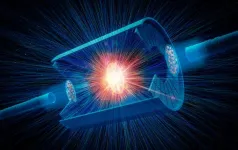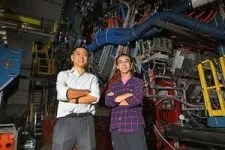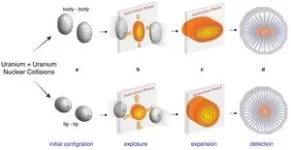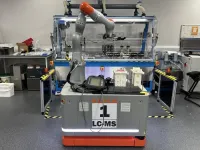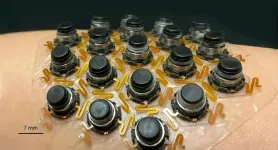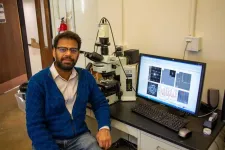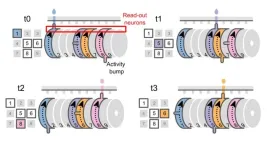(Press-News.org) UPTON, N.Y. — Scientists have demonstrated a new way to use high-energy particle smashups at the Relativistic Heavy Ion Collider (RHIC) — a U.S. Department of Energy (DOE) Office of Science user facility for nuclear physics research at DOE’s Brookhaven National Laboratory — to reveal subtle details about the shapes of atomic nuclei. The method, described in a paper just published in Nature, is complementary to lower energy techniques for determining nuclear structure. It will add depth to scientists’ understanding of the nuclei that make up the bulk of visible matter.
“In this new measurement, we not only quantify the overall shape of the nucleus — whether it’s elongated like a football or squashed down like a tangerine — but also the subtle triaxiality, the relative differences among its three principle axes that characterize a shape in between the ‘football’ and ‘tangerine,’” said Jiangyong Jia, a professor at Stony Brook University (SBU) who has a joint appointment at Brookhaven Lab and is one of the principal authors on the STAR Collaboration publication.
Deciphering nuclear shapes has relevance to a wide range of physics questions, including which atoms are most likely to split in nuclear fission, how heavy atomic elements form in collisions of neutron stars, and which nuclei could point the way to exotic particle decay discoveries. Leveraging improved knowledge of nuclear shapes will also deepen scientists’ understanding of the initial conditions of a particle soup that mimics the early universe, which is created in RHIC’s energetic particle smashups. The method can be applied to analyzing additional data from RHIC as well as data collected from nuclear collisions at Europe’s Large Hadron Collider (LHC). It will also have relevance to future explorations of nuclei at the Electron-Ion Collider, a nuclear physics facility in the design stage at Brookhaven Lab.
Ultimately, since 99.9% of the visible matter that people and all the stars and planets of the cosmos are made of resides in the nuclei at the center of atoms, understanding these nuclear building blocks is at the heart of understanding who we are.
“The best way to demonstrate the robustness of nuclear physics knowledge gained at RHIC is to show that we can apply the technology and physics insights to other fields,” Jia said. “Now that we’ve demonstrated a robust way to image nuclear structure, there will be many applications.”
From long exposure to freeze-frame snapshots
For decades, scientists used low-energy experiments to infer nuclear shapes — for example, by exciting the nuclei and observing photons, or particles of light, emitted as the nuclei decay back to the ground state. This method probes the overall spatial arrangement of the protons inside the nucleus, but only at a relatively long time scale.
“In low-energy experiments, it’s like taking a long-exposure picture,” said Chun Shen, a theorist at Wayne State University whose calculations were used in the new analysis.
Because the exposure time is long, the low-energy methods do not capture all the subtle variations in the arrangement of protons that can occur inside a nucleus at very fast timescales. And because most of these methods use electromagnetic interactions, they can’t directly “see” the uncharged neutrons in the nucleus.
“You only get an average of the whole system,” said Dean Lee, a low-energy theorist at the Facility for Rare Isotope Beams, a DOE Office of Science user facility at Michigan State University. Though Lee and Shen are not co-authors on the study, they and other theorists have contributed to developing this new nuclear imaging method.
“The high-energy imaging method, which captures many freeze-frame snapshots that reveal information about both the protons and neutrons, is orders of magnitude faster,” said Chunjian Zhang, a former SBU postdoctoral fellow, now a junior faculty member at Fudan University, who co-led the STAR analysis.
Importantly, the snapshots taken by RHIC’s STAR detector all come from different collision events.
“You cannot image the same nuclei again and again because you destroy them in the collision,” Jia noted. But by looking at the whole collection of images from many different collisions, scientists can reconstruct the subtle properties of the 3D structure of the smashed nuclei.
As Lee explained, “In each collision, you freeze time for a moment and look at where all the protons and neutrons are. And every time you do this, it’s a different distribution due to the quantum nature of atomic nuclei. So, the high-energy method captures a ton of information, a ton of complexity that we do not probe in low-energy experiments.”
Reconstructing shapes from debris
How exactly does STAR see that complexity if the nuclei get destroyed? By tracking how particles fly out — and how fast — from the most central, head-on nuclear smashups.
As the STAR scientists note in their Nature paper, “In an ironic twist, this effectively realizes [famous physicist] Richard Feynman’s analogy of the seemingly impossible task of ‘figuring out a pocket watch by smashing two together and observing the flying debris.’”
From years of experiments at RHIC, the scientists know that high energy nuclear collisions melt the protons and neutrons of the nuclei to set free their inner building blocks, quarks and gluons. The shape and expansion of each hot blob of this melted nuclear matter, known as a quark-gluon plasma (QGP), is determined by the shape of the colliding nuclei. The shape and size of each QGP blob directly affect pressure gradients generated in that blob of plasma, which in turn influence the collective flow and momentum of particles emitted as the QGP cools.
The STAR scientists reasoned they could “reverse engineer” this relationship to derive information about nuclear structure. They analyzed the flow and momentum of particles emerging from collisions and compared them with models of hydrodynamic expansion for different QGP shapes to arrive at the shapes of the originally colliding nuclei.
To show their method worked, they compared central collisions of gold nuclei — which are believed, from low energy studies, to be close to spherical — with central collisions of uranium nuclei, which have a pronounced elongated football-like shape. Because the gold nuclei are nearly spherical, there shouldn’t be much variation from collision to collision in the flow patterns of emitted particles.
“Central collisions of gold nuclei produce a circular, fixed size QGP that expands evenly in all directions,” said Shengli Huang, a SBU research scientist who co-led the STAR analysis. “The oblong uranium nuclei, on the other hand, can collide in a wide range of orientations, generating droplets of QGP with various shapes and sizes,” he said. So, the scientists expected central collisions of uranium to exhibit much more variability in the flow patterns.
This is what they observed.
By comparing measurements between uranium-uranium and gold-gold collisions — and fitting those results to hydrodynamic models that have successfully described other characteristics of the QGP — the scientists were able to infer a quantitative description of the shape of the uranium nucleus. The results also include a first determination of the relative lengths of the three principal axes of the oblong uranium nucleus.
Computing tools
Obtaining precision predictions from various hydrodynamic models, including Shen’s model, posed significant computational challenges. Accomplishing this task took over a year, with Zhang running calculations on the Open Science Grid. Zhang used more than 20 million central processing unit (CPU) hours to produce more than ten million collision events from hydrodynamic models, which were then fitted to the experimental data.
“Many features in the STAR data are indicative of the significant differences in the shape between the uranium and gold nuclei, but the computational data-model comparisons certainty helped us to more precisely quantify the nuclear shapes,” Zhang said.
Though this study aimed to establish a new nuclear imaging method, the data did reveal some new information about uranium nuclei. Instead of observing distortion in just the one principal axis that leads to “prolate” elongation, the scientists found differences in all three axes, suggesting that uranium nuclei are more complex than previously thought.
Expanded impacts
As noted, the new method will improve physicists’ understanding of the initial conditions in heavy ion collisions that generate QGP at both RHIC and the LHC. Nuclear structures derived from low-energy experiments were essential in analyses that linked those initial conditions with hydrodynamic flow patterns to establish that the QGP created in these collisions is a nearly perfect liquid. Scientists can now use the new method to check the consistency with low-energy approaches using nuclei like uranium where the structure is relatively well known. This will further reduce uncertainties about initial state conditions to improve the determination of QGP properties.
The method can also be used to determine shapes of other nuclei, especially those where the low-energy experiments yielded limited understanding. One example would be to apply the method to so-called isobar nuclei — nuclei with the same total number of protons and neutrons (nucleons), but different proportions of each type. Such pairs are involved when two neutrons in a higher-neutron-number “parent” nucleus transform into protons via a nuclear weak decay process to create the lower-neutron-number “daughter” — a process known as double beta decay. Knowing the shape differences between parent and daughter nuclei could help reduce model uncertainties in experiments searching for an unseen type of decay known as neutrinoless double beta decay.
“There are many interdisciplinary aspects of this research,” Jia explained. “Nuclear physics has many subfields. Usually, each community uses its own tools — theory and experiments. But because of these results, the low-energy nuclear structure and nuclear reaction communities around the world have taken notice. Several workshops, meetings, and conferences were organized to explore the connections between the high-energy and low-energy frontiers in nuclear physics, which allowed us to understand each other better,” he said.
This work was supported by the DOE Office of Science, the U.S. National Science Foundation (NSF), and a range of international agencies and organizations listed in the scientific paper. In addition to using the Open Science Grid, supported directly by NSF, the researchers made use of computing resources in the Scientific Data and Computing Center at Brookhaven Lab and the National Energy Research Scientific Computing Center (NERSC), which is another DOE Office of Science user facility at DOE’s Lawrence Berkeley National Laboratory.
Brookhaven National Laboratory is supported by the Office of Science of the U.S. Department of Energy. The Office of Science is the single largest supporter of basic research in the physical sciences in the United States and is working to address some of the most pressing challenges of our time. For more information, visit science.energy.gov.
Follow @BrookhavenLab on social media. Find us on Instagram, LinkedIn, X, and Facebook.
END
Imaging nuclear shapes by smashing them to smithereens
Scientists use high-energy heavy ion collisions as a new tool to reveal subtleties of nuclear structure with implications for many areas of physics
2024-11-06
ELSE PRESS RELEASES FROM THIS DATE:
AI-driven mobile robots team up to tackle chemical synthesis
2024-11-06
Researchers at the University of Liverpool have developed AI-driven mobile robots that can carry out chemical synthesis research with axtraordinairy efficiency.
In a study publishing in the journal Nature, researchers show how mobile robots that use AI logic to make decisions were able to perform exploratory chemistry research tasks to the same level as humans, but much faster.
The 1.75-meter-tall mobile robots were designed by the Liverpool team to tackle three primary problems in exploratory chemistry: performing the reactions, ...
New haptic patch transmits complexity of touch to the skin
2024-11-06
A Northwestern University-led team of engineers has developed a new type of wearable device that stimulates skin to deliver various complex sensations.
The thin, flexible device gently adheres to the skin, providing more realistic and immersive sensory experiences. Although the new device obviously lends itself to gaming and virtual reality (VR), the researchers also envision applications in healthcare. For example, the device could help people with visual impairments “feel” their surroundings or give feedback to people with prosthetic limbs.
The ...
Safety of simultaneous vs sequential mRNA COVID-19 and inactivated influenza vaccines
2024-11-06
About The Study: In this randomized clinical trial assessing simultaneous vs sequential administration of mRNA COVID-19 and inactivated influenza vaccines, reactogenicity was comparable in both groups. These findings support the option of simultaneous administration of these vaccines.
Corresponding Author: To contact the corresponding author, Emmanuel B. Walter, MD, MPH, email chip.walter@duke.edu.
To access the embargoed study: Visit our For The Media website at this link https://media.jamanetwork.com/
(doi:10.1001/jamanetworkopen.2024.43166)
Editor’s Note: Please see the article for additional information, including other ...
Long-term risk of autoimmune and autoinflammatory connective tissue disorders following COVID-19
2024-11-06
About The Study: This retrospective cohort study with an extended follow-up period found associations between COVID-19 and the long-term risk of various autoimmune and autoinflammatory connective tissue disorders. Long-term monitoring and care of patients is crucial after COVID-19, considering demographic factors, disease severity, and vaccination status, to mitigate these risks.
Corresponding Author: To contact the corresponding author, Solam Lee, MD, PhD, email solam@yonsei.ac.kr.
To access the embargoed study: Visit our For The Media website ...
Mount Sinai researchers have uncovered the mechanism in the brain that constantly refreshes memory
2024-11-06
Mount Sinai researchers have discovered for the first time a neural mechanism for memory integration that stretches across both time and personal experience. These findings, reported in Nature, demonstrate how memories stored in neural ensembles in the brain are constantly being updated and reorganized with salient information, and represent an important step in deciphering how our memories stay current with the most recently available information. This discovery could have important implications for better understanding adaptive memory processes ...
Breakthrough in energy-efficient avalanche-based amorphization could revolutionize data storage
2024-11-06
The atoms of amorphous solids like glass have no ordered structure; they arrange themselves randomly, like scattered grains of sand on a beach. Normally, making materials amorphous — a process known as amorphization — requires considerable amounts of energy. The most common technique is the melt-quench process, which involves heating a material until it liquifies, then rapidly cooling it so the atoms don’t have time to order themselves in a crystal lattice.
Now, researchers ...
Scientists discover how specific E. coli bacteria drive colon cancer
2024-11-06
Ghent, 7 November 2024 – Scientists have uncovered how certain E. coli bacteria in the gut promote colon cancer by binding to intestinal cells and releasing a DNA-damaging toxin. The study, published in Nature, sheds light on a new approach to potentially reduce cancer risk. The study was performed by the teams of Prof. Lars Vereecke (VIB-UGent Center for Inflammation Research) and Prof. Han Remaut (VIB-VUB Center for Structural Biology).
Bacteria and colon cancer
Colon cancer ranks as the third most prevalent and deadliest type of cancer. Alarmingly, its incidence is rising, particularly ...
Brain acts like music box playing different behaviours
2024-11-06
Neuroscientists have discovered brain cells that form multiple coordinate systems to tell us “where we are” in a sequence of behaviours. These cells can play out different sequences of actions, just like a music box can be configured to play different sequences of tones. The findings help us understand the algorithms used by the brain to flexibly generate complex behaviours, such as planning and reasoning, and might be useful in understanding how such processes go wrong in psychiatric ...
Study reveals how cancer immunotherapy may cause heart inflammation in some patients
2024-11-06
Some patients being treated with immune checkpoint inhibitors, a type of cancer immunotherapy, develop a dangerous form of heart inflammation called myocarditis. Researchers led by physicians and scientists at the Broad Institute of MIT and Harvard and Massachusetts General Hospital (MGH), a founding member of the Mass General Brigham healthcare system, have now uncovered the immune basis of this inflammation. The team identified changes in specific types of immune and stromal cells in the heart that underlie myocarditis and pinpointed factors in the blood that may indicate ...
More families purchased school meals after federal nutrition policies enacted
2024-11-06
Families purchased more school lunches and breakfasts the year after the federal government toughened nutritional standards for school meals. A new University of California, Davis, study suggests that families turned to school lunches after the Obama administration initiative was in effect to save time and money and take advantage of more nutritious options.
Researchers looked at the purchasing habits of nearly 8,000 U.S. households over two years — one year before and after the change in standards. The results have important implications for policymakers and researchers, but also food manufacturers and retailers, researchers said.
The study, ...
LAST 30 PRESS RELEASES:
First Editorial of 2026: Resisting AI slop
Joint ground- and space-based observations reveal Saturn-mass rogue planet
Inheritable genetic variant offers protection against blood cancer risk and progression
Pigs settled Pacific islands alongside early human voyagers
A Coral reef’s daily pulse reshapes microbes in surrounding waters
EAST Tokamak experiments exceed plasma density limit, offering new approach to fusion ignition
Groundbreaking discovery reveals Africa’s oldest cremation pyre and complex ritual practices
First breathing ‘lung-on-chip’ developed using genetically identical cells
How people moved pigs across the Pacific
Interaction of climate change and human activity and its impact on plant diversity in Qinghai-Tibet plateau
From addressing uncertainty to national strategy: an interpretation of Professor Lim Siong Guan’s views
Clinical trials on AI language model use in digestive healthcare
Scientists improve robotic visual–inertial trajectory localization accuracy using cross-modal interaction and selection techniques
Correlation between cancer cachexia and immune-related adverse events in HCC
Human adipose tissue: a new source for functional organoids
Metro lines double as freight highways during off-peak hours, Beijing study shows
Biomedical functions and applications of nanomaterials in tumor diagnosis and treatment: perspectives from ophthalmic oncology
3D imaging unveils how passivation improves perovskite solar cell performance
Enriching framework Al sites in 8-membered rings of Cu-SSZ-39 zeolite to enhance low-temperature ammonia selective catalytic reduction performance
AI-powered RNA drug development: a new frontier in therapeutics
Decoupling the HOR enhancement on PtRu: Dynamically matching interfacial water to reaction coordinates
Sulfur isn’t poisonous when it synergistically acts with phosphine in olefins hydroformylation
URI researchers uncover molecular mechanisms behind speciation in corals
Chitin based carbon aerogel offers a cleaner way to store thermal energy
Tracing hidden sources of nitrate pollution in rapidly changing rural urban landscapes
Viruses on plastic pollution may quietly accelerate the spread of antibiotic resistance
Three UH Rainbow Babies & Children’s faculty elected to prestigious American Pediatric Society
Tunnel resilience models unveiled to aid post-earthquake recovery
Satellite communication systems: the future of 5G/6G connectivity
Space computing power networks: a new frontier for satellite technologies
[Press-News.org] Imaging nuclear shapes by smashing them to smithereensScientists use high-energy heavy ion collisions as a new tool to reveal subtleties of nuclear structure with implications for many areas of physics
